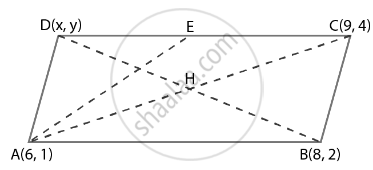Advertisements
Advertisements
प्रश्न
A(6, 1), B(8, 2) and C(9, 4) are three vertices of a parallelogram ABCD. If E is the midpoint of DC, find the area of ∆ADE.
उत्तर
According to the question,
The three vertices of a parallelogram ABCD are A(6, 1), B(8, 2) and C(9, 4)
Let the fourth vertex of parallelogram = (x, y),
We know that, diagonals of a parallelogram bisect each other
Since, mid-point of a line segment joining the points (x1, y1) and (x2, y2) is given by,
`((x_1 + x_2)/2, (y_1 + y_2)/2)`
Mid-point of BD = Mid-point of AC
`((8 + x)/2, (2 + y)/2) = ((6 + 9)/2, (1 + 4)/2)`
`((8 + x)/2, (2 + y)/2) = (15/2, 5/2)`
So, we have,
`(8 + x)/2 = 15/2`
⇒ 8 + x = 15
⇒ x = 7
And
`(2 + y)/2 = 5/2`
⇒ 2 + y = 5
⇒ y = 3
So, fourth vertex of a parallelogram is D(7, 3)
Now,
Mid-point of side
DC = `((7 + 9)/2, (3 + 4)/2)`
E = `(8, 7/2)`
∵ Area of ΔABC with vertices (x1, y1), (x2, y2) and (x3, y3);
= `1/2`[x1(y2 – y3) + x2(y3 – y1) + x3(y1 – y2)]
∴ Area of ΔADE with vertices A(6, 1), D(7, 3) and `"E"(8, 7/2)`
Δ = `1/2[6(3 - 7/2) + 7(7/2 - 1) + 8(1 - 3)]`
= `1/2[6 xx ((-1)/2) + 7(5/2) + 8(-2)]`
= `1/2(35/2 - 19)`
= `1/2((-3)/2)`
= `(-3)/4` but area can’t be negative
Hence, the required area of ΔADE is `3/4` sq.units.
APPEARS IN
संबंधित प्रश्न
If A(−4, 8), B(−3, −4), C(0, −5) and D(5, 6) are the vertices of a quadrilateral ABCD, find its area.
The two opposite vertices of a square are (− 1, 2) and (3, 2). Find the coordinates of the other two vertices.
Let A (4, 2), B (6, 5) and C (1, 4) be the vertices of ΔABC.
(i) The median from A meets BC at D. Find the coordinates of point D.
(ii) Find the coordinates of the point P on AD such that AP: PD = 2:1
(iii) Find the coordinates of point Q and R on medians BE and CF respectively such that BQ: QE = 2:1 and CR: RF = 2:1.
(iv) What do you observe?
(v) If A(x1, y1), B(x2, y2), and C(x3, y3) are the vertices of ΔABC, find the coordinates of the centroid of the triangle.
Four points A (6, 3), B (−3, 5), C(4, −2) and D (x, 3x) are given in such a way that `(ΔDBG) /(ΔABG)=1/2,` find x
Show that the points O(0,0), A`( 3,sqrt(3)) and B (3,-sqrt(3))` are the vertices of an equilateral triangle. Find the area of this triangle.
Show that the following points are collinear:
A(-5,1), B(5, 5) and C(10, 7)
Find the value of x for which points A(x, 2), B(-3, -4) and C(7, -5) are collinear.
If the area of triangle ABC formed by A(x, y), B(1, 2) and C(2, 1) is 6 square units, then prove that x + y = 15 ?
Find the missing value:
| Base | Height | Area of parallelogram |
| ______ | 15 cm | 154.5 cm2 |
In the given figure, if PR = 12 cm, QR = 6 cm and PL = 8 cm, then QM is ______.

